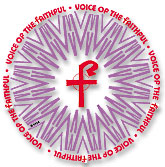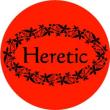Even though Gerald at The Cafeteria is Closed said that the history lesson he had posted with graphics was not a parody and that it was from from New Jersey’s VOTF actual online church history lesson, I had to look at their site to see for myself. Now as a satirist I don’t appreciate it when VOTF does something that parodies itself. Even funnier is that Voice of the Faithful which always tries to portray itself as a group faithful to the Church would as part of its history lesson have the reader read specified pages in a book by Hans Kung!
If you need some good laughs please look over the several history lessons offered by VOTF. The clipart thrown in to the lesson make it even funnier. There short section on St. Thomas Aquinas displays the old "How man angels can dance on the head of a pin?" myth. St. Thomas Aquinas nor any scholastic ever advanced this question. This was in fact a Protestant slander and like many of these similar slanders are taking for granted now as true.
Their view of history really shows them for the heretics that most of their leadership is. Over and over they bash papal primacy and make claims that the early councils did not recognize the authority of the Pope and that these popes had very little influence. Of course they don’t explain why some canons from a council that were subsequently rejected by a pope were removed from the canons.
There history lesson on the enlightenment was not very enlightened.
While this was going on, the Enlightenment created a new paradigm which led to a separation.
The individual person became the center, and freedom of conscience became important as a human right.
Consistent to the end, popes react to this new paradigm with sterile protests and sweeping condemnations.
They forgot that the first thing that normally got separated was someones head from their shoulders. How dare a Pope react to a new paradigm that killed thousands of people especially priests and religious and tried to ban religious believers from the public square.
Yes VOTF is so faithful that they even attack the dogma of infallibility defined at Vatican I and try to frame it as a way to keep the papal states. They even describe the Old Catholic Church that went into schism after Vatican I as Catholic but Rome-free and that they hold to the faith of first millennium churches. Yeah I remember all those early churches that ordained women
The history that VOTF has come up with could have been written by any anti-Catholic which I think is pretty telling. Though their whole idea of ecclesiology is of its very essence Protestant in the first place.
So in the spirit of the graphics on their history site:
 |
 |
 |

16 comments
Oh man, they don’t even have their art history down right. First, I mean, when Kung is your authority for this stuff…well, you’ve got problems.
Secondly, the image down at the bottom of the link is of Constantine IX, husband of the Empress Zoe which dates from, I believe (if I remember my dates from my History of Byzantine Art class correctly) the 7th century.
Wow.
-Harrison
At the bootom of Cluster1:
“Here are some questions to get our discussion started… Remember, there are no right or wrong answers: … Do you think that Jesus envisioned a particular Church structure with institutional rules and regulations?”
No right or wrong answers eh? Participants better get this one “right” or they will be out on their @#$&.
Oops, that should be “bottom” not bootom!
I too noticed that approving nostalgia for the “Old Catholic Church” of pre-Vat 1 times – a church free of all those accretions etc. So if they deny the dogmatic teaching of V1 and presumably subsequent Popes, then how come they jump back on board with John XXIII (or John XXXIII as their site refers to him as)?
Oh my gosh, that VOTF site is hilarious! I haven’t seen anything that funny since the Jack Chick “Tim & Jim” comic books.
I’ve often said that Jack Chick and John Calvin together made me a Catholic. I’ll now say that if I’d seen the VOTF site at the same time, I’d be giving credit to VOTF as well. They have to be kidding, no?
Re the angels dancing on the head of a pin, Dorothy Sayers has this to say.
The Lost Tools of Learning
Dorothy Sayers
http://www.gbt.org/text/sayers.html
� A glib speaker in the Brains Trust once entertained his audience (and reduced the late Charles Williams to helpless rage by asserting that in the Middle Ages it was a matter of faith to know how many archangels could dance on the point of a needle. I need not say, I hope, that it never was a “matter of faith”; it was simply a debating exercise, whose set subject was the nature of angelic substance: were angels material, and if so, did they occupy space? The answer usually adjudged correct is, I believe, that angels are pure intelligences; not material, but limited, so that they may have location in space but not extension. An analogy might be drawn from human thought, which is similarly non-material and similarly limited. Thus, if your thought is concentrated upon one thing–say, the point of a needle–it is located there in the sense that it is not elsewhere; but although it is “there,” it occupies no space there, and there is nothing to prevent an infinite number of different people’s thoughts being concentrated upon the same needle-point at the same time. The proper subject of the argument is thus seen to be the distinction between location and extension in space; the matter on which the argument is exercised happens to be the nature of angels (although, as we have seen, it might equally well have been something else; the practical lesson to be drawn from the argument is not to use words like “there” in a loose and unscientific way, without specifying whether you mean “located there” or “occupying space there.”
Even while reading it I thought it was a joke. This especially caught my eye:
“First, there were the Albigensians in southern France and the Waldensians scattered across Western Europe.
Their overall programs were a mixed bag but they did emphasize asceticism, itinerant preaching and a LAY CHURCH STRUCTURE!”
That they so shamelessly idolize heresies is amazing to me.
I am laughing at this for another reason. They stole my technique. (cf http://www.angelfire.com/ma4/cathedral/votf.htm) Well, imitation is the sincerest form of flattery. I am flattered. (However, they do not do this as good as I do.)
Further it also seems they perpetuate that ancient of Catholic myths: that Catholics must never read the bible. In their case, we must instead read the apocryphal Book of Kung.
When VOTF began, I said it would go the way of Call to Action in 5 years. Right now, VOTF is generally irrelevant to everyone but themselves. The only thing that gives them currency is our taking notice of them.
There’s an old adagy in show business; “I don’t care what you say about me, just as long as you say something.”
Can we all agree to ignore VOTF forever?
F.
You are right. It’s kinda hard to parody someone when they are a self-parody and don’t realize it.
Scott
I’m more than happy to ignore their site, but can’t ignore the peril in which they are placing their souls. Time to put up reminder from Mother Theresa to pray hard for them.
Their logo is obnoxious. I mean, really – a takeoff on the Eucharist and the Chi-Rho, only instead of the initials of Our Lord it’s the third and fourth initials of their group’s name. Having “The Faithful” (meaning them) in the place of Christ in the center of the Eucharist, which is the Body and Blood of Our Lord, is a dead giveaway. Symbolically speaking, it neatly expresses their theology and ecclesiology.
I find the very existance of VOTF to be a joke. You see, I’m a member of VOTF. Why? Um, because they decided I was! I don’t know if anyone else got hit by this, but evidentally they got hold of my e-mail address when I scolded them about something. So I was e-mailed a chance to vote on their recent elections of officers. I didn’t vote, but I wished I’d have had time to e-mail all my friends and relatives (both Christian and not) to get on VOTF and vote me in as president. The first thing I’d institute is sackcloth and ashes and perhaps that fasting-onto-death practiced by some of their favourite heretics. But since I’m not the president, I’ll just pray for them.
.
On an even less serious note, did you catch that one of the themes of the “history” course is: “probing the issue, given that history, what reforms and renewal can take place to make the Church what it could be?” It sounds like one of those arts and crafts classes in which participants try to figure out different things they can do with paper: “It could be a hat!” “Oh, it could be a boat!” Or gee, you could not have ANY reforms and the Church could be what it could be!
To be fair, this site does seem to be run by a.n. woman in a local branch of VOTF, not by the high heidjins (if they have such things).
Very worrying. An upsettingly loose grasp on chronology, there. It seems to be recommending watching(!) “THe NAme of the Rose” to get a feel for the… tenth century. Um. Hello?!
Well, one could go on, but what’s the point? Anyone out there want to fund a mass mailing of RW Southern’s “Western Society and the Church in the Middle Ages”?
Sigh. Sancte Thomas, ora pro nobis.
Man, these people have a genius for unwittingly self-revelatory iconography (see last comment but two). In the midst of an extremely tortured line of argument, they insert – the Laoco�n group! Here’s how an art historian speaks of it:
“It depicts an event in Vergil’s Aeneid (Book 2). The Trojan priest Laoco�n was strangled by sea snakes, sent by the gods who favored the Greeks, while he was sacrificing at the altar of Neptune. Because Laoco�n had tried to warn the Trojan citizens of the danger of bringing in the wooden horse, he incurred the wrath of the gods.”
In other words, someone who tried to warn the people of disaster and invoke heavenly protection, is attacked and silenced by those inimical to the well-being of his people. Geez, these people give themselves away at every turn.
Just out of curioisty–are there any, um, you know, faithful people in Voice of the Faithful?
That last graphic could be expanded to:
Heretics => VOTF => Heretics